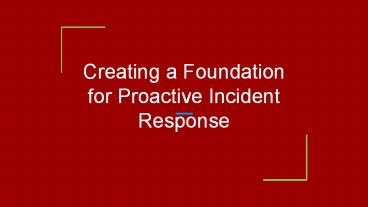Creating a Foundation for Proactive Incident Response - PowerPoint PPT Presentation
Title:
Creating a Foundation for Proactive Incident Response
Description:
Before your SOC can set its incident response process into motion, there needs to be an effective method to accurately identify real threats. The average SOC gets thousands of alerts per day, and weeding out false positives to focus on actual threats can be challenging. With a security orchestration platform in place, your ecosystem of security technologies can work together to deliver vital context that lets your team know where their focus is most needed. – PowerPoint PPT presentation
Number of Views:64
Title: Creating a Foundation for Proactive Incident Response
1
Creating a Foundation for Proactive Incident
Response
2
Introduction
- As a Boy Scout, youre trained to be prepared -
always in a state of readiness in mind and body
to do your duty. And for many of us in
cybersecurity, a sense of duty is what drew us to
the industry in the first place. What happens
when the mind and body are at the ready, but you
don't have the right approach or tools to carry
out your duty as you know you can and should?
3
Quarterly Incident Response Threat Report
4
Effective Incident Detection
- Before your SOC can set its incident response
process into motion, there needs to be an
effective method to accurately identify real
threats. The average SOC gets thousands of alerts
per day, and weeding out false positives to focus
on actual threats can be challenging. With a
security orchestration platform in place, your
ecosystem of security technologies can work
together to deliver vital context that lets your
team know where their focus is most needed.
5
Decisive Incident Detection
- With security orchestration and automation, these
crucial details are automatically gathered and
presented to your security team, enabling them to
assess the priority of an alert, quickly close
false positives and clearly identify which
security events would trigger applying your
incident response process. This ultimately helps
drive down mean time to detect (MTTD) which, when
combined with a proactive incident response plan
will also lead to a faster mean time to respond
(MTTR).
6
Security Orchestration for Proactive IR
- The QIRTR identifies six steps for taking a more
proactive approach to incident response. Of those
security orchestration has a significant impact
on the first four - Have an incident response plan in place
- Communicate and notify
- Know your legal requirements
- Visibility is key
- Hunt quietly
- Regular checkups multi-factor authentication
7
Effective Incident Response
- For effective incident response - your entire
security team needs to know what steps to take A
and when. This means having a clear, documented
plan that is periodically tested through
simulations to assess effectiveness and
continuously improve. - One of the key benefits offered by security
orchestration platforms is the ability to codify
your incident response plans into consistent,
repeatable playbooks.
8
Leverage Security Orchestration
- Because security orchestration gives your team a
complete picture of an incident, it can also help
your team do the necessary postmortem and
reporting to satisfy legal requirements. Some
security orchestration and automation platforms
offer automated reporting that provides a
snapshot of the security incident as well as a
summary of the playbooks applied and remediation
steps taken.
9
Be Ready To Proactively Communicate Notify
10
Conclusion
- Utilizing all available information and having it
presented to analysts in a clear, usable way
ensures that the security team has all the data
needed to perform deep analysis and determine the
best incident response approach rapidly. - By channeling our inner Boy Scouts and taking a
more proactive approach to incident response
enabled by security orchestration, we can help
our security operations teams more quickly,
effectively and consistently identify and respond
to threats.































